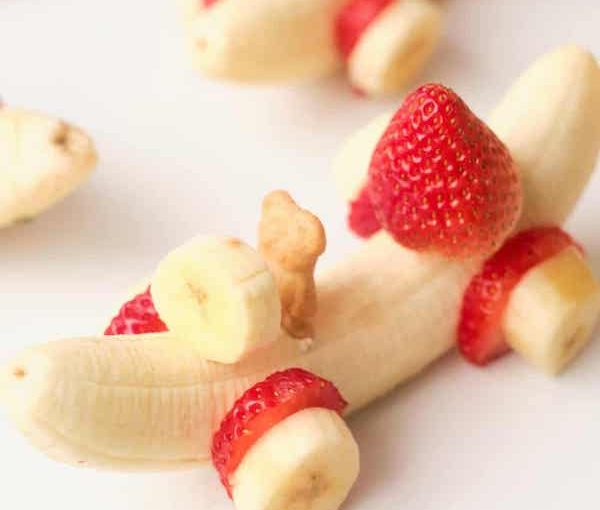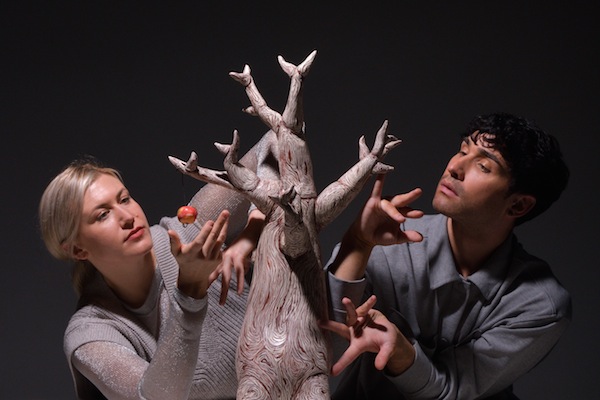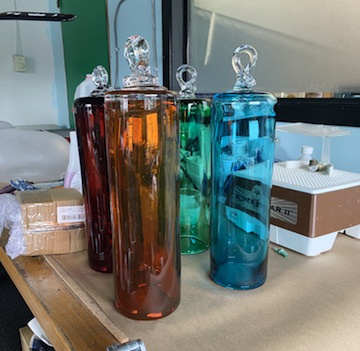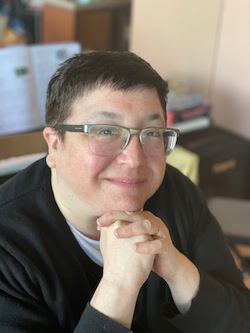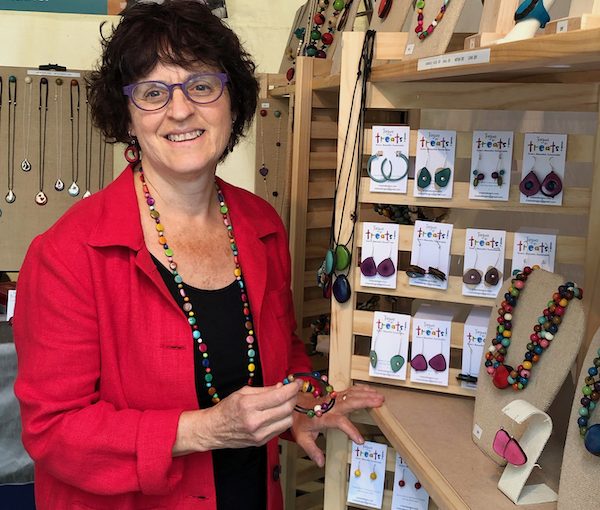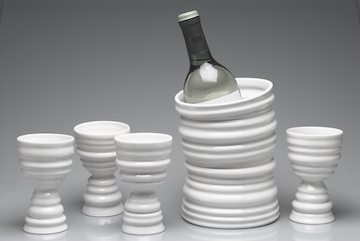Healthy food can make for a fun snack. The website hello, Yummy has lots of ideas about cooking for and with kids. This banana car with strawberry wheels and a graham cracker bear driver is but one option. (photo from helloyummy.co)
If I had a dollar for every time I heard a parent tell their kid to stop playing with their food, I’d be a very rich woman. I might even be able to afford a kosher prime rib roast. That being said, I’m here to tell you that sometimes it’s perfectly acceptable to play with your food. Like when there’s a banana strawberry car involved. Or maybe some peanut butter.
Anticipating the visit of my grand-nephew and grand-niece got me thinking about how we could have some fun together in the kitchen – without sending anyone to hospital or having to move afterwards. The 3-year-old, Raphael, loves to help his mom cook and bake, so I figured this would be the perfect way to bond with him. His 1-year-old sister, Ariel, might not be adept enough for the culinary process, but I’m sure she’ll eagerly participate in the finished product.
I think we can all agree that food is more fun when you can play with it. It brings out the inner kid in us, the one who’s just dying to squish mashed potatoes through our teeth. Unseemly behaviour for an adult? Sure. Have we all done it? You betcha. And who among us hasn’t rolled Wonderbread into soft little balls? The fact that edible toys are, for the most part, healthy, is a win-win. You just need to make good food choices.
For the super-fun banana car snack I found online (helloyummy.co) all you need is a banana, a couple of strawberries, some peanut butter to attach the “wheels” to the body of the banana car and a graham cracker “driver” (an animal cracker hippo or elephant works perfectly well, too). As for the strawberry “wheels” you could replace them with thick slices of kiwi, mango or even grapes. If you really want to get decadent, you could dip the banana wheels into melted chocolate, add a red licorice tailpipe, or tuck some raisins or blueberries into the “wheels” to simulate hubcaps. The possibilities are truly endless.
While the original recipe calls for using toothpicks to attach the wheels to the body of the car, I’m hesitant to do that, considering there’s a 3-year-old and a 1-year-old involved. It’s a foregone recipe for disaster.
Instead, I’m sticking with peanut butter as the adhesive (a glob of cream cheese could also work in a pinch). And, yes, I checked with their mom first to make sure neither of them is allergic to peanuts. Given that both kids were practically weaned on Bamba (the peanut-flavoured melt-in-your-mouth Israeli snack food), I figured I was safe on that count, but it’s always good to check with the parents.
Since I’m not sure of the practical play factor of these banana car snacks, there won’t be any makeshift racetracks as part of this edible experiment. (Will the wheels even turn? I doubt it.) Although I did see lots of great ideas on Google and Instagram.
Lucky for me that little Raphael and Ariel are the opposite of picky eaters. In fact, they’ll pretty much devour anything in sight. It doesn’t matter how esoteric, spicy, slimy, crunchy or smelly it is, they’re game to try it. And, if you transform the food into some kind of insect, animal or character they recognize, even better. All it takes is a bit of ingenuity and some basic foodstuffs. The look of sheer wonder on a kid’s face when they see an insect made out of celery, apples and pretzels, and then you tell them they can eat it – well, nothing beats that.
So, go ahead and play with your food, make mealtime and snack time fun, and let your imagination soar. It’s unquestionably a healthier choice than plopping kids down in front of a screen, plus it encourages innovation, resourcefulness and artistic expression.
Aside from fun food snacks, I’m a bit addicted to Instagram for all the cool DIY toys you can make for toddlers and preschoolers using nothing more than leftover paper towel rolls, ping pong balls, a plastic straw, a bit of tape and some kids scissors. As a former children’s librarian, I have all sorts of craft tricks up my sleeve, and I love the uniqueness of homemade toys. But I definitely need a craft refresh now and again.
I’m always a little disheartened by the number of adults whose go-to gifts involve ordering overpriced toys online. I know that not everyone has the time or inclination to make a gift, but I sometimes think our culture has just gotten lazy. And how many times have you seen a well-intentioned adult (with a lot of disposable income) buy a 2-year-old a $75 toy only to have the kid show more interest in the box or the bubble wrap? Expensive does not always equate to fabulous toys. Put some time and thoughtfulness into it, and I guarantee your DIY gift will be memorable.
The second summer of the pandemic, I made a bunch of felt animals for then-2-year-old Raphael and, according to his parents, he loved them. He’d stick them on any surface within reach, and they were a great way to learn animal names and have fun doing it. I’m not saying they were newsworthy, but they were all handmade with love.
And making them was not as onerous as you might think. Just find some free templates on Google, print them out, buy some felt and glue at the dollar store, do some tracing, and boom – you’ve got yourself some mighty fine felt board animals. Aside from putting them on surfaces throughout the house, you can cover a poster-size piece of corrugated plastic with felt (again, dollar store material) and use the animals to make up stories on the board.
It’s my belief that, if you make it, they will come. If you buy it, they may just play with the box instead. See you at the grocery or dollar store.
Shelley Civkin, aka the Accidental Balabusta, is a happily retired librarian and communications officer. For 17 years, she wrote a weekly book review column for the Richmond Review. She’s currently a freelance writer and volunteer.

